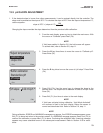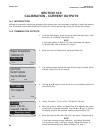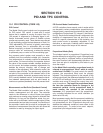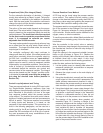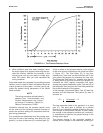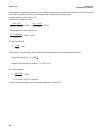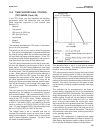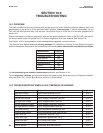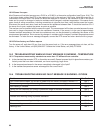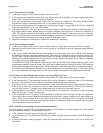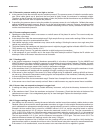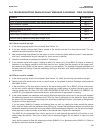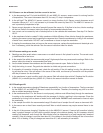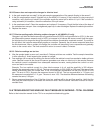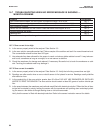
MODEL 54eA SECTION 16.0
TROUBLESHOOTING
16.2.1 High input current
Excessive sensor current implies that the amperometric sensor is miswired or the sensor has failed. Verify that
wiring is correct, including connections through a junction box. See Section 3.3. If wiring is correct, try replacing
the sensor.
16.2.2 Check sensor zero
The sensor current was extremely high when the sensor was zeroed. Refer to the calibration section for the ana-
lyte being determined for typical zero currents. Zeroing the sensor before the zero current has reached a stable
minimum value will lead to low results. Allow adequate time, possibly as long as overnight, for the sensor to sta-
bilize before starting the zero routine. Also refer to the troubleshooting section specific for the sensor. See the table
in Section 16.1.
16.2.3 pH low or high input voltage
The input voltage fault message usually means there is an open connection somewhere in the wiring between the
pH sensor and controller. Check wiring connections. See Section 3.3. If a junction box is being used, check the
connections at the junction box, too. If wiring is correct, try replacing the sensor.
16.2.4 pH low or high reference voltage
The reference voltage fault message can mean several things: the pH sensor is no longer submerged in the
process, the sensor is coated or fouled, or there is an open connection between the sensor and the controller. First,
verify all electrical connections. If a junction box is being used, check the connections at the junction box, too.
Verify that the pH sensor is completely submerged in the process liquid. Also, verify that the sensor is not coated
with solids or oil. If the sensor looks dirty, clean it. Refer to the sensor instruction manual for details. If cleaning the
sensor fails to solve the problem, replace the sensor.
16.2.5 Old glass warning
Old glass warning means the pH sensor is no longer submerged in the process or the sensor is possibly nearing
the end of its useful life. First, verify that the sensor is clean and submerged in the process liquid. Also verify that
the sensor can still be calibrated in buffers. Make a note of the sensor slope. If the slope is between 54 and 60
mV/ unit pH, the sensor is good. If the slope is between 48 and 50 mV/unit pH, the sensor is near the end of its
life. To make the warning message disappear, increase the warning limit (see Section 5.8).
16.2.6 Cracked glass failure
This fault message almost always means the pH sensor has failed and must be replaced. Before discarding the
sensor, try calibrating it in buffers. If the buffer calibration is successful, the sensor is okay, but the diagnostic limit
is set too high. To make the fault message disappear, lower the glass failure limit (see Section 5.8, step 6). Do not
lower the impedance below 10 MΩ.
16.2.7 Temperature error low or high
Temperature error usually means the RTD (or the thermistor in the case of the Hx438 and Gx448 sensors) is open
or shorted or there is an open or short in the connecting wiring. First, verify all wiring connections, including wiring
connections in the junction box if one is being used. Next, disconnect the RTD IN, SENSE, and RETURN leads or
the thermistor leads at the controller. Be sure to note the color of the wire and where it was attached. Measure the
resistance between the RTD IN and RETURN leads. For the thermistor, measure the resistance between the two
leads. The resistance should be close to the value in the table in Section 16.14.2. If the temperature element is
open or shorted, the sensor should be replaced. In the meantime use manual temperature compensation.
For oxygen measurements using the Hx438, the Gx448, or other steam sterilizable sensor using a 22kNTC, tem-
perature error high will appear if the controller was not properly configured to recognize the sensor. Verify that
either “RMT Biopharm” or “SSDO other” was selected in Section 5.5.
87



